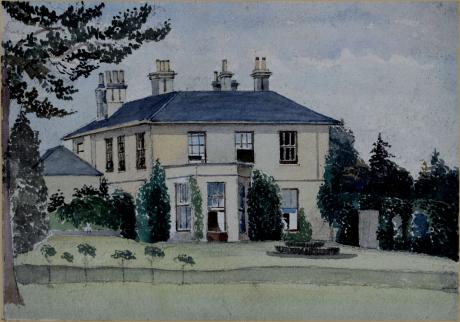inscribed and dated in the margin " Larling Rectory, Norfolk June 1873"
Larling House, Watton Road Larling Norfolk NR16 is a delightful and well-appointed country house which is believed to date originally from the early 19th Century. The main house is Grade II Listed and was formerly known as The Old Rectory. The house was lived in by the author Middleton Murry, whose father owned the house, and it provided the inspiration for many of his novels. It was regularly visited by D H Lawrence during this time.
The critic and political writer John Middleton Murry (1889-1957) moved into the Old Rectory at Larling in 1931. Murry was the editor of The Adelphi - a radical journal which he founded in 1923. He also had a close friendship with D. H. Lawrence. In 1931 he published a controversial study of Lawrence entitled Son of Woman. His first wife, the short story writer Katherine Mansfield, died of tuberculosis. His second wife Violet le Maistre also succumbed to the same illness and, in a state of grief, he married his housekeeper Betty Cockbayne. Betty was a highly emotional and volatile person who frequently flew into violent rages which made life at Larling extremely difficult for both Murry and his children.
Colin and Katherine Middleton Murry - who were his children by Violet - both wrote autobiographies which dealt with their upbringing at Larling. In Beloved Quixote Katherine recalled her step mother's terrible fits of temper. Colin's memories were entitled One Hand Clapping and Shadows on the Grass but were slightly less troubled. Later in life, Murry became interested in self supporting agricultural communities and set up Lodge Farm at Thelnetham - just over the border in Suffolk. He finally found happiness here with his fourth wife Mary Gamble. Ironically, after searching all his life for a creed, he finally settled for the Church of England; he is buried in the churchyard at Thelnetham.
Larling is a village and part of the civil parish of Roudham and Larling, in the English county of Norfolk. The village is 8.5 miles east north east of Thetford, 21.4 miles west south west of Norwich and 94 miles north east of London. Larling has an entry in the Domesday Book of 1085. In the great book Larling is recorded by the name ‘’Lur(i)inga’’. The main landholder is William de Warenne with the main tenant being Hugh. The survey also mentions a mill.
The still-standing medieval church was built in the 12th century, and was expanded in the 1340s creating the chancel, with a tower later being added in the 16th century. The church is built of flint, with stone used only for dressings. The tower is in the 15th-century Perpendicular style. On the north side there is a staircase turret that leads to the belfry. The windows date from the 15th century also. There is an ornamented Norman doorway, with one of the pillars carrying a mass dial. Inside the church is a four-sided font from the 12th century. The walls used to be covered in decorative paintings, one of them including a large painting of St Christopher. An organisation under the name 'Friends of Thurton Church' continue to help raise money for future restorations and the ongoing maintenance of the church.
Shrubb family is one of the longest running communal communities in England. Founded in 1970 in a 17th-century cottage near the old A11 and the Angel pub, the membership and fortunes of the community have fluctuated over the years, but the ethos of low impact living and environmental harmony have persisted.Shrubb is listed on the Diggers and Dreamers online directory and there is a video of the early days at Shrubb on YouTube titled 'Shrubb Family 1973 part 1 & 2'. Shrubb is featured in "Communes in Britain" by Andrew Rigby, 1974. As of recent years the membership of the group has fluctuated and has been left with around 6 members.


